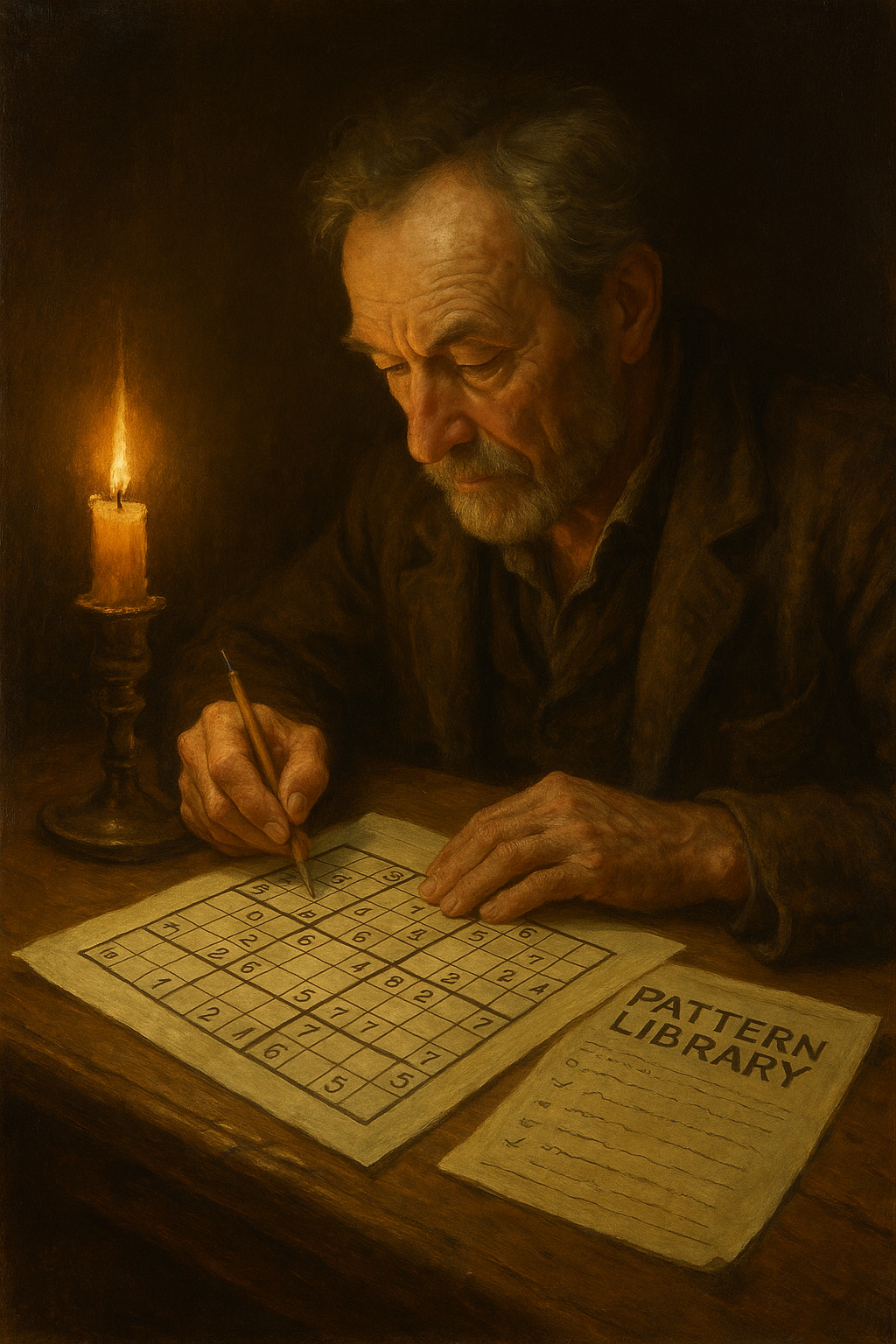
From Candidates to Certainty: Build Your Sudoku Pattern Library
Picture this: you’ve scanned the Sudoku grid twice and nothing moves—until a tiny detail in a 3×3 box snaps into focus: a naked pair you somehow kept overlooking. In an instant, the grid unlocks. Moments like this are not luck; they’re the consequence of trained pattern recognition. What if you could engineer more of them?
A quick teaser.
In this piece you’ll learn how to:
- Codify patterns so they become automatic
- Track the lag between spotting and acting
- Clean up your notes to prevent false moves
- Use a short micro-drill that hard-wires advanced techniques
We’ll also show how lightweight analytics can surface exactly which motifs you miss most often—and how to fix that.
Why a Pattern Library Beats Ad-Hoc Solving
Patterns drive efficient Sudoku. “I’ll figure it out as I go” works—until the puzzle climbs to Hard/Expert and ad-hoc logic stalls. A pattern library is simply a curated set of named motifs you recognize at a glance:
- Singles (hidden & naked)
- Pairs/Triples/Quads (naked, hidden)
- Pointing pairs / box–line reduction
- Fish patterns (X-Wing, Swordfish)
- Wings & chains (XY-Wing, XYZ-Wing, simple coloring)
When these are explicit, you stop “hunting randomly” and start sweeping deliberately.
Reflective Questions
- Which patterns do you confidently see, and which remain “urban legends” you rarely catch?
- Do you sweep rows → columns → boxes in a fixed cycle—or bounce around the grid?
- Are your pencil marks consistent enough that patterns pop visually—or does clutter hide them?
- When you place a digit, do you prove the elimination path, or do you sometimes trust a hunch?
A Simple System to Grow Your Library
Step 1: Normalize Your Notes
- One notation, always. Use a single candidate style (corner marks, no center digits). Consistency converts patterns from thinking to seeing.
- Declutter aggressively. After each placement, clear stale candidates in the affected row/column/box to prevent phantom options.
Step 2: Pattern-of-the-Week
- Read a concise definition you trust (keep it to two rules, max).
- Spot it on at least one grid per day.
- Record whether you found it before or after a hint/solution reveal.
- Review on day 7: did your “time-to-spot” shrink?
Step 3: Error Reconstructions
When a puzzle collapses late, rebuild the last 8–12 moves and tag the root cause: misread candidates, missed reduction (pointing pair), or skipped scan cycle. Error libraries make tomorrow’s success inevitable.
Micro-Practice: The 120-Second Pattern Sprint
- Set a 2:00 timer. Choose an Easy/Medium grid.
- Pass 1 (40s): singles only—no exceptions.
- Pass 2 (40s): naked pairs/triples.
- Pass 3 (40s): box–line reductions.
Log cells placed and which pass created the most progress. Over a week, the mix should shift from Pass 1 → Pass 2/3 as you start seeing structures faster.
👉 To put this into practice right away, open a fresh grid and run your first sprint.
Analytics That Matter (and Why)
- Time-to-first-fill (TFF): seconds from start to first correct entry—lower indicates a strong opening scan.
- Pattern-spot lag (PSL): time between “noticing” and “placing.” Collapse PSL via consistent notes.
- Weighted mistake rate (WMR): count errors near the endgame more heavily; these are the morale killers.
- Stall frequency: number of >60s pauses per puzzle—use this to choose your next pattern focus.
You can track these in a simple sheet or lean on your platform stats. For a quick pulse check, glance at your Sudoku stats dashboard after each session.
Health & Focus Note (Real-World Data, No Hype)
Large cohort research prior to 2024 has repeatedly shown that frequent engagement with number puzzles is associated with better performance on reasoning, memory, and processing-speed tests in older adults.
Effects are generally modest but meaningful. Correlation isn’t causation, and Sudoku isn’t medical treatment—but routinely challenging your brain with structured logic tasks is a low-risk way to support cognitive fitness.
Methodology & Research Workflow (Transparent)
- Data gathering: aggregated platform stats (solve time distributions, success rates) and personal logs of TFF/PSL/WMR; no user-identifiable data.
- Literature review: pre-2024 peer-reviewed findings on cognitive effects of number puzzles and logic training; triangulated across multiple reviews.
- Limitations: observational data may overstate effects; platform analytics differ by implementation.
Summary & Call to Action
Build your pattern library, normalize your notes, sprint for 120 seconds a day, and track what actually changes. The grid will feel lighter, your decisions quicker, and your endgames cleaner.
Ready to put it into action? Start your next session and play sudoku online free—then log your TFF and PSL right after your first puzzle.
What pattern will you master this week?

 German
German
 Japanese
Japanese
 Arabic
Arabic
 Spanish
Spanish
 French
French
 Russian
Russian
